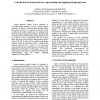Free Online Productivity Tools
i2Speak
i2Symbol
i2OCR
iTex2Img
iWeb2Print
iWeb2Shot
i2Type
iPdf2Split
iPdf2Merge
i2Bopomofo
i2Arabic
i2Style
i2Image
i2PDF
iLatex2Rtf
Sci2ools
87
Voted
COMPSAC
2007
IEEE
2007
IEEE
A model-driven framework for representing and applying design patterns
Design patterns encode proven solutions to recurring design problems. To use a design pattern properly, we need to 1) understand the design problem the pattern resolves, 2) recognize an instance of this problem in the model at hand, and 3) to transform the model to produce the proposed solution. We argue that an explicit representation of the design problem solved by a pattern is key to supporting each one of these tasks. We propose to represent a design pattern using a triple (MP, MS, T) where MP is a model of the design problem solved by the pattern, MS is a model of the solution proposed by it, and T is a rule-based representation of the transformations embodied in the application of the pattern. In this paper, we describe the principles underlying our approach and the current implementation using the Eclipse Modeling Framework™ and JRules™.
Related Content
| Added | 02 Jun 2010 |
| Updated | 02 Jun 2010 |
| Type | Conference |
| Year | 2007 |
| Where | COMPSAC |
| Authors | Ghizlane El-Boussaidi, Hafedh Mili |
Comments (0)

